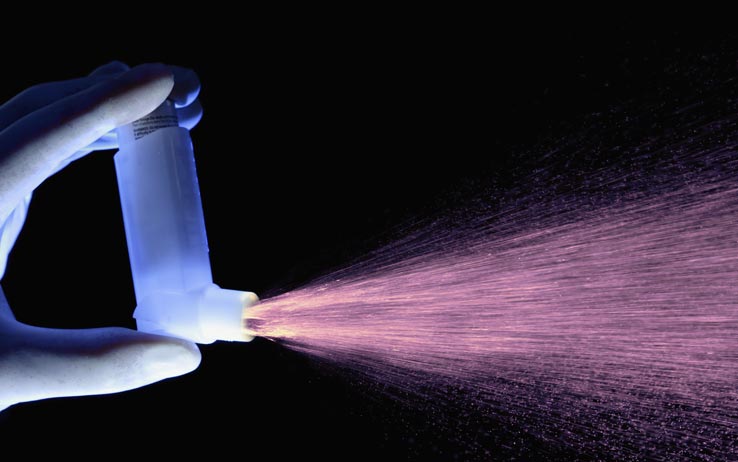Bronchial asthma is an allergic disease characterized by recurrent panting attacks because of bronchi spasm, their swollen mucous membrane or a long-lasting cough. Asthma is one of the most common diseases. Canadian Health&Care Mall has a great number of various inhalers and other medicaments to help cope with your health problems as quick as possible.
Recent studies show that between 4 and 10 % of the world’s population suffers from this disease of varying severity. Among children, this index rises to 10-15 %. Despite the clear definition of the disease, florid symptoms and great potential for research methods, bronchial asthma is often diagnosed as various forms of bronchitis, and, as a result, is inefficiently and inadequately treated with antibiotics and anti-tussive medications. 3 of 5 patients are diagnosed asthma at severe disease stages.
Symptoms of asthma:
- occasional attacks, panting or cough;
- sibilant rale occurrence;
- the tightness of the chest and cough.
An important clinical sign of the disease is a subsidence of symptoms spontaneously or after bronchodilators and anti-inflammatory drugs administration. The following facts are important: further exacerbations, often triggered by allergens or cold and moist air, physical exercise, different smells, crying, laughing, or viral infection, as well as the seasonal variability of symptoms and atopic disease of the patient.

What Causes Asthma?
- Hereditary factor. As a rule, at least one member of the patient’s family suffers from this disease or another allergic disease (allergic rhinitis, atopic dermatitis, etc.);
- Climatic factor. Climate, soil, elevation determine the frequency of attacks. For example, low clouds, cyclones, large air mass fronts moving cause an attack twice more often compared to quiet weather. Speaking of soil, it should be mentioned that clayed soil contributes to asthma development in 93,8% of cases. In valleys and on plains with high groundwater level the disease occurs more often;
- Seasonal factor. Some patients are sensitive to high and low temperatures, that is why exacerbations occur during winter and summer months. Individual patients’ seasonality of disease occurrence may be connected to the blooming period of certain plants (ambrosia, alder, birch, etc.)
Asthma Pathogenesis
You can get acquainted with asthma pathogenesis in this video:
The basis of an attack or coughing, which is a sign of bronchial asthma, is bronchi inflammation, often immune. If an allergen (plant pollen, mites, house dust) or allergy pathogen (streptococcus, fungi, staphylococcus, etc.) gets into bronchi, the complex immune mechanism is triggered — production of bioactive substances, some activation of some cells. Bronchi structure and functions are damaged: swollen mucosa, bronchial smooth muscles spasm, changing bronchial mucous nature (sputum). Sputum becomes thick and viscous, hard to discharge blocks bronchial lumen. Air that came into pulmonary alveoli on inhale, can’t pass out through the narrowed inner bronchial lumen. A patient can hardly exhale – there is expiratory dyspnea, a specific feature of bronchial asthma. A patient also makes rhonchi.
The panting degree can be quantified. For this purpose spirography and peakflowmetry are used. Spirography’s main indicator is forced expiratory volume during the first second (FEV1). Peakflowmetry’s peak volumetric expiratory rate (PVE) indicator is almost as important.An immune inflammatory process is constant and can’t be got rid of independently without treatment. Exceptions are the cases of atopic asthma, caused by the seasonal blooming period.
Course of Bronchial Asthma
Asthma course can be divided into exacerbation and remission periods. The severity of the disease is estimated basing on the following criteria:
- the number of night attacks per week;
- the number of day-time attacks per day and per week;
- the necessity to use short-acting b2-agonists during the day;
- physical activity and sleep disorder intensity;
- changes in respiratory functions indicators (FEV1 and PVE) during exacerbation period and their absence during remission period;
- diurnal PVE variability.
According to its severity bronchial asthma is divided into 4 degrees: intermittent (episodic), persistent (continuous) mild, moderately severe and severe course.
Bronchial asthma of intermittent (episodic) course:
- night attacks – not more than 2 times per month;
- day-time attacks – less than 1 time per week;
- short-term exacerbations – from a few hours to a few days;
- the normal respiratory function during exacerbations;
- FEV1, PVE > 80 % of predicted;
- diurnal PVE variability 80% of predicted;
- diurnal PVE variability 20-30%.
 Bronchial asthma of persistent (continuous) moderately severe course:
Bronchial asthma of persistent (continuous) moderately severe course:
- night attacks – more than 1 time per week;
- constant day-time attacks;
- exacerbations damage working capacity, physical activity and sleep;
- daily short-acting b2-agonists intake is necessary;
- FEV1, PVE 60 80% of predicted;
- diurnal PVE variability > 30%.
Bronchial asthma of persistent (continuous) severe course:
- frequent night attacks;
- continuous day-time attacks;
- frequent exacerbations;
- significant physical activity disorder;
- FEV1, PVE < 60% of predicted;
- diurnal PVE variability 20-30%.
Examination
Patients with bronchial asthma undergo a close pulmonary and allergological examination. The main task is to identify the causes of the disease, disease development mechanisms, comorbidities, including allergic ones.
Treatment and Prevention
Asthma treatment depends on the development mechanism and exacerbation and remission periods severity. If connections to the allergen are stated, a specific treatment is indicated – vaccination with the identified allergen. In addition to that, a basic therapy with inhalers and another symptomatic therapy indicated. The dosage, drugs, and frequency of administration are determined by a doctor. After doctors assignment, you can apply to Canadian Health&Care Mall for getting the best service and high-quality medicaments online in one click. Our experts will help you find everything you need in no time and at a reasonable price.
In order to prevent attacks, it is necessary to minimize allergens’ penetration into the bronchi, prevent recrudescence or infection process in the lungs and bronchi, regularly keep to selected therapy and control respiratory functions parameters. All these issues are solved at asthma school.
Health is the most valuable human resource! Do not get sick and take care of yourself, because no money can buy it for you! Listen to your internal organs, timely undergo examinations and health surveys – this is the most valuable contribution to longevity and the life free of problems.

